Book contents
- Frontmatter
- Contents
- Preface
- 1 Introduction
- 2 Numerical Scheme for Treating Convection and Pressure
- 3 Computational Acceleration with Parallel Computing and Multigrid Method
- 4 Multiblock Methods
- 5 Two-Equation Turbulence Models with Nonequilibrium, Rotation, and Compressibility Effects
- 6 Volume-Averaged Macroscopic Transport Equations
- 7 Practical Applications
- References
- Index
2 - Numerical Scheme for Treating Convection and Pressure
Published online by Cambridge University Press: 30 March 2010
- Frontmatter
- Contents
- Preface
- 1 Introduction
- 2 Numerical Scheme for Treating Convection and Pressure
- 3 Computational Acceleration with Parallel Computing and Multigrid Method
- 4 Multiblock Methods
- 5 Two-Equation Turbulence Models with Nonequilibrium, Rotation, and Compressibility Effects
- 6 Volume-Averaged Macroscopic Transport Equations
- 7 Practical Applications
- References
- Index
Summary
In this chapter we present some recent developments in the treatment of convective and pressure fluxes. There is an abundance of information on convection schemes for Euler and Navier-Stokes equations in the literature. No attempt is made here to summarize the various schemes proposed to date. Instead we focus on a controlled variation scheme (CVS) developed in the context of pressure-based algorithms that treat the convective and pressure fluxes separately. The attention of this chapter is on developing the formalism for TVD-based higher-order schemes for pressure-based methods and on demonstrating the accuracy of such schemes. We first begin with a summary of the basic methodology of pressure-based methods (Patankar 1980, Shyy 1994), which constitute one of several classes of successful techniques for handling complex transport problems (Ferziger and Peric 1996, Fletcher 1988, Hirsch 1990). The discussion presented in this chapter is equally applicable to other numerical algorithms as well.
Summary of Pressure-Based Algorithms
All the computations to be presented in this book have been conducted with a pressure-based algorithm that has been very widely used for several engineering applications. A more detailed discussion of pressure-based methods for complex geometries can be found in Shyy (1994). The algorithm we have developed can handle complex three-dimensional flow domains. However, in this chapter, we will present the governing equations in two dimensions for the sake of clarity of development of the controlled variation scheme presented in the next section. The extension to three-dimensional cases is straightforward (Shyy 1994).
Information
- Type
- Chapter
- Information
- Computational Techniques for Complex Transport Phenomena , pp. 24 - 59Publisher: Cambridge University PressPrint publication year: 1997
Accessibility standard: Unknown
Why this information is here
This section outlines the accessibility features of this content - including support for screen readers, full keyboard navigation and high-contrast display options. This may not be relevant for you.Accessibility Information
- 1
- Cited by
